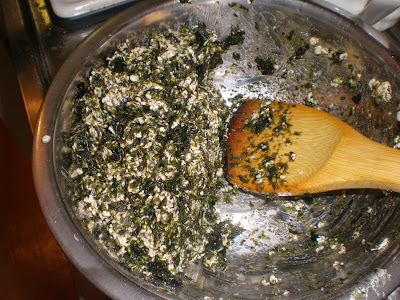So I recently decided to make bara lawr (laverbread, literally のりパン) for the staff at GenkiJACS. There are various reasons. One is that it came up in conversation a couple of times. I wondered whether people here wouldn't like it, considering savoury seaweed foods are a pretty major thing here. I was interested in the challenge of making passable bara lawr here. And I just sort of felt like it.
The main obstacle is that although nori is very similar to the lawr I'd normally use, it's processed differently. Lawr I buy tinned and boiled; it's soft and salty. Searching for nori, I was only able to find it roasted and dried into sheets or shreds. This makes a substantial difference to the flavour, that evasively indescribable roastedness, and also leaves it far less salty. However, a few notes around the internet suggested that it can be done.
The absolute first step will, perhaps, seem very strange in making a seaweed-based recipe. I went to several shops, and eventually managed to buy a packet of bacon.
I began by shredding sheets of yakinori (roasted nori) and putting it to soak. I was relieved to find the seaweed readily absorbed the water and reconstituted into a familiar green slime, although it took a lot of mixing to break it up from the chunks it had been pressed into, and it didn't quite achieve the texture I'm used to by the time I gave up. I chucked in a bit of salt; I'm always quite conservating about adding salt because of health concerns, and it turned out I should have added more. I also dropped in a little pepper, because I tend to add pepper to most savoury things.
Thankfully, oats are fairly easy to get because porridge is a known thing here, so I added the same volume of oats and began stirring. The small remnants of excess moisture from the rehydration were easily absorbed here.
With the mixture ready, I slathered it onto a chopping board and cut it into slabs for ease of cooking. The traditional recipe is for thicker, rounded cakes, but I was trying to make enough for quite a lot of people, most of whom probably wouldn't want very much - either because they wouldn't like it, or just because it's random food being brought into the office. It's not like cooking for a party. So this was less than a centimetre thick and sized for easy flipping.
Next, bring out the bacon! Dropping in just a little lard to start the pan going, I fried up eight strips of bacon (four at a time), carefully, letting them drip dry over the pan once I'd finished. For proper bara lawr, you really should be frying in bacon fat.
The bacon is certainly not going to waste - I stored it in the freezer, and I'll use it up one strip at a time to add flavour to simple meals. In fact, I had one in my bento just the next day.
Fat ready to go, I fried up the cakes, a minute or so on each side. Normally it takes a bit longer, but these cakes were thin, and I suspect the rehydrated nori was a bit dryer than the usual stuff, so I kept it brief. A quick taste-test suggested they were acceptable, if not really tasting the same as the real product.
The finished product I left to cool and dry for a while - don't want any leftover fat making them greasy. I gave it a quick pat with kitchen paper to help deal with that. I then cut it into smaller pieces, and put it into a box layered with silicon paper to take to school, popping it in the fridge overnight just on general principles. It shouldn't be a big health issue to keep it around uncooled, but it's generally a good idea, especially in this hot climate.
I'm pleased to report that I've had several enthusiastic reviews, including Mayumi-sensei who took some leftover pieces home to have toasted with butter for breakfast! Those people who didn't like it maintaining a tactful silence. That being said, one unfortunate thought I'd generously brought them chocolate cookies and got a nasty shock.
Recipe for Mock Bara Lawr
If you can get real tinned lawr, or some kind of boiled nori, it will be more authentic and less hassle. However, dried nori can also work.
- Some nori
- Oats
- Salt
- Bacon fat, lard, or cooking oil (in that order of preference)
- If you are using yakinori or other dried nori, shred it and leave in water for half an hour. Thoroughly mix and mash the rehydrated nori to break down lumps, and drain off any obvious excess water while leaving it moist.
- If you are using non-salty nori (like yakinori) add salt to taste. Authentic bara lawr is fairly salty.
- Mix the nori with an equal volume of oats or oatmeal. Stir well. It will become a stiff paste.
- Shape the paste into flattish cakes, somewhere between 5mm and 2cm thick as you prefer. A thicker cake will stay soft in the middle and have a lower fat content.
- Fry the paste in fat, for 1-2 minutes per side. The oats will brown as it becomes ready.
- Ideally, eat immediately as part of a cooked breakfast or meal. Best eaten with a non-salty accompaniment.
模擬のりパンの製法
間違いをご免ください。授業で製法を書きません!
ほんとの茹でたのりでほうが伝統なバララウルを作れます。ウェルスのラウルは茹でて売ります。それでも、焼きのりでも作れます。
- のり
- オーツ
- 塩
- ベーコン脂身か、ラードか、それとも油(優先に並べられた)
- 焼きのりだったら、切り裂いて30分水につけてふやかします。それから、かき回します。余分な水があったら、出しますが、湿っているままはいい。
- 焼きのりでも使ったら、塩を入れます。バララウルは塩辛いあじで作りたい。
- 湿っているのりはオーツの同じ体積と組み合しましてかき回す。ペースト状になるまでかき回します。
- ペーストは5ミリから2センチまでの厚さがる個にします。厚くするとともに、中は柔らかく続く、油の含有量は少なくなります。
- 毎側を少し油で1-2分丈焼きます。オーツが茶色くなります。
- 一番いいのは、作ってから食べます。塩辛くない食べ物と食べるのはほうが美味し。





No comments:
Post a Comment